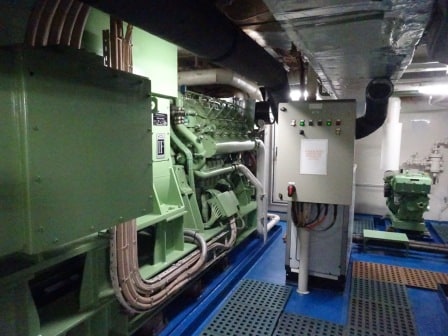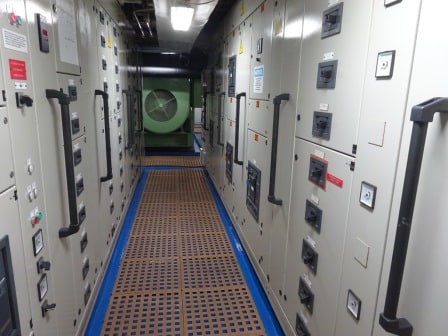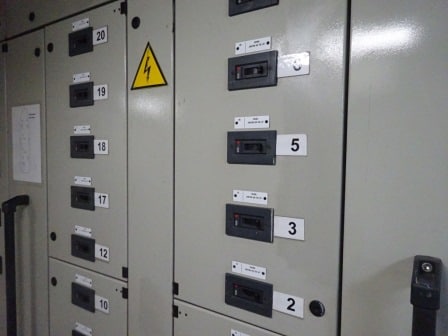It is still very windy out there but we now have following wind; which means the relative wind on the deck is the real wind minus the ships speed. The ship is doing 12 knots; the apparent or relative wind is 18 knots, so it is still blowing 30 knots out at sea. And 30 knots is a big 6 or a small 7 on the Beaufort scale. Very windy. Sailors call that a Very Strong Breeze or a Near Gale. All caused by the regular Trade Wind being super charged by large weather systems North of Puerto Rico. I think the word Near Gale comes from the observation of it being very windy but not yet that windy that it feels stormy. Still there is a lot more wind than there should be in this area. Most of the Zuiderdam’s open deck spaces are screened off by large glass partitions so the guests can still sit out of the wind if they want to. Only the aft deck around the pool is open on three sides and that brings the danger that the cooler sea air does not make you feel that hot; and then you forget that you are baking in the Caribbean sun. Some guests forgot it today but will remember it tomorrow and the days after.
A bit more engine stuff today. Now outside the engine room, with the fascinating question, what happens if all the engines stop? Do all the lights go out? The answer is no. In the unlikely case of a full black out, when all the engines have stopped or the two Main switchboards have a major hic-up, we still keep the lights on.

The Emergency Diesel Generator, with next to it a small diesel engine in case we run out of starting air for the EDG.
When all the power would stop, the Emergency Diesel Generator (EDG) would come on line and provide sufficient power for the ship to stay in minimal operation. That happens by itself. The electric setup is so that when the main power goes down, within a maximum of 10 seconds the EDG has to come on line. In reality it goes much faster. But the 10 seconds are a requirement and when we have USCG inspection or Lloyd’s renewal of our certificates the EDG is always tested. Although we then do not make a real black out, we simulate by pulling fuses. The EDG powers all the emergency lighting, all the bridge and Engine Control Room equipment, lights in the corridors etc.etc. It does not power air conditioning and toilets. For that we have another auxiliary engine. The EDG powers what is legally required. It does include elevators, one in every staircase. On every cruise ship you can recognize those as there are small green signs on every deck indicating which one it is.

The Emergency Switchboard. Two sides so it can bring power down to each of the Two main switchboards we have in the engine room. In the back the EDG.
The EDG is located near the top of the ship on deck 10, so if the ship would be sinking it could keep happily running until everybody had left the ship.
Now what would happen if the EDG would not start? It normally starts as a regular Diesel Engine with air which comes from an Air pressure vessel. If that tank or drum would be empty, then we have another smaller air compressor standing next to the EDG which would then fill up the Air tank again until it would have sufficient pressure to start the EDG again. The EDG has sufficient Gas oil to run for at least 24 hours. Ours can do at least 36 hours and if we can get more gas oil there (or mgo) then it can run indefinitely.
Now what if we would eventually run out of MGO or the EDG would break down? Then we still have batteries. A whole room full and they are capable of providing power for all the emergency lighting in the ship for at least 4 hours. Thus making it possible for everybody to safely disembark also during the night time. (Remember lifeboats do not need power to go down in the Davits as they are gravity operated)

All the Elevators are connected to the EDG so the Ch. Engineer can decide which ones should run during an emergency, or if the power is sufficient keep even more of them on line.
Most guests only notice the existence of the EDG when they hear the announcement that we carry out the weekly test and we ask them to refrain from using the Elevators while this is going on. This is because we bring the EDG on line (Engineers called that “under full load”) and thus only four elevators need to continue to work. So the other ones might stop and then descend by themselves to deck 3 (lifeboat deck) and the open the doors. Not dangerous but a bit startling for a guest who was convinced that he or she was on the way to deck 9 for an early lunch.
Tomorrow we are in Cartagena and we expect to be at the pilot station around 05.30 am and to be docked an hour later. Weather forecast: Mainly overcast with a chance of showers. 31oC or 88oF. but very little wind inside the port. Overcast is not a bad thing as most of our guests will be on tour. Hopefully we get our chance of showers after the early afternoon departure.

March 13, 2017 at 7:45 pm
Pretty impressive, Captain. All the many backup systems that are installed. I wonder if they were all in place on board the Statendam in 2012?
The blackout that year lasted quite a while. That happened before you took over command in Seward from Captain Frans Consen. I was staying on board for the return to Vancouver.
If you remember that occasion, would you explain what happened then? I do remember the Chief Officer at the time used a Dutch expression I’d never heard before to show he was somewhat nervous about the time lapse of the black out …
March 14, 2017 at 6:08 pm
Yes I remember , although I joined the ship when it was all over. But the EDG was running, as it should, for all the safety stuff. We just had no power for anything else, so everybody called it a black out, but the ship was only in a complete black out for three seconds until the EDG came on line.
Best regards
Capt. Albert
March 14, 2017 at 1:27 am
I am very glad I did not miss today’s lesson in Emergency ship power! I am writing down my packing list (and, of course, it is too long but filled with every ‘necessary’ thing) for a Transatlantic in less than a month. Of course I am looking forward to 7 days at sea, but that vast distance between ports had me a little worried about ‘what if?’– I am used to cruises that are a little closer to shore. Today’s blog crosses off one of the ‘what if’ questions (i.e., what if the ship loses power in the middle of the atlantic??). I do hope that after seeing other ships’ misfortunes, the generator for the toilets has plenty of fuel available too… 😉
I guess working in the engine room guarantees that you will not be a human lobster 🙂
Thanks again for all of your blog posts!
March 14, 2017 at 5:12 pm
Hi Captain Albert: A little humor here !
I don’t understand why all you HAL Captains are always yammering about the wind in Oranjestad’s Paarden Baai. It (the Passaat wind) has been that way for ages. Pirates in sailing ships dealt with it !!. From someone who lived there in the 50’s and therefore an expert, here is how you do it. No thrusters required !! (please note: I haven’t actually tried this !)
Out in open sea, go full speed in same relative direction as the dock . Then hit full reverse (shaking, vibrations, prop ventilating/cavitation and all) and figure out from GPS data how far it takes the ship to stop relative to ground to the nearest meter. Be sure to get the measurement units right (feet, meters etc.)
Then use that same full speed going into the reef sheltered Paarden Baai, aiming for 5 to 10 feet off the dock. At the precise lead point determined by the previous research, order the engine room “full reverse”, and then when all the turmoil is over, lie still along the dock before the wind even realizes you are there. Lines out, and you’re good to go !! Passengers should be OK to go ashore in a few hours.
Glad to help out with persisting problems. Your long time friend Ruud Hartog.
March 14, 2017 at 6:00 pm
Thank you for your “sound advice”. Although it works on paper, I am afraid that the various authorities in power would not agree with a try-out. Much safer to moan and groan than to take decisive action……………..
Best regards
Capt.Albert
March 15, 2017 at 7:34 pm
Many thanks, Captain Albert ! Amazing how we, passengers, exaggerate when the real black out lasted only three seconds.